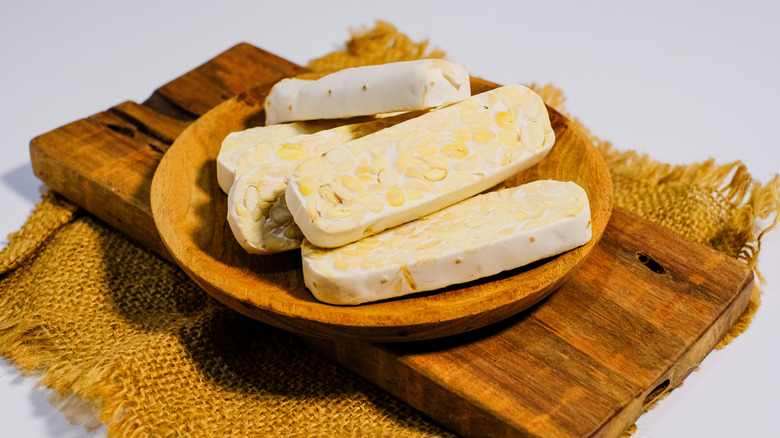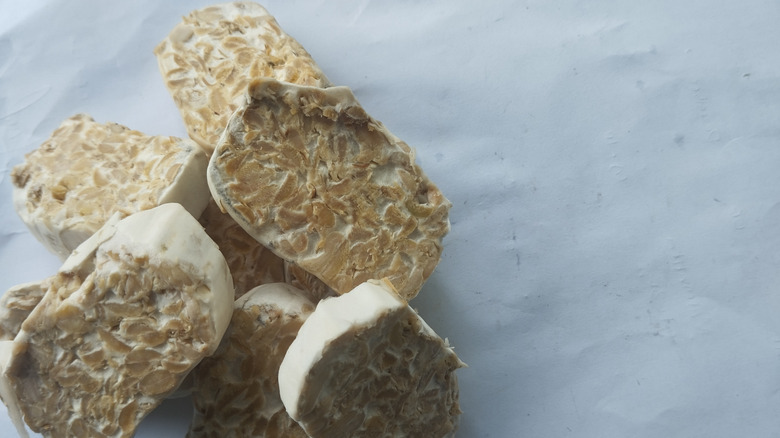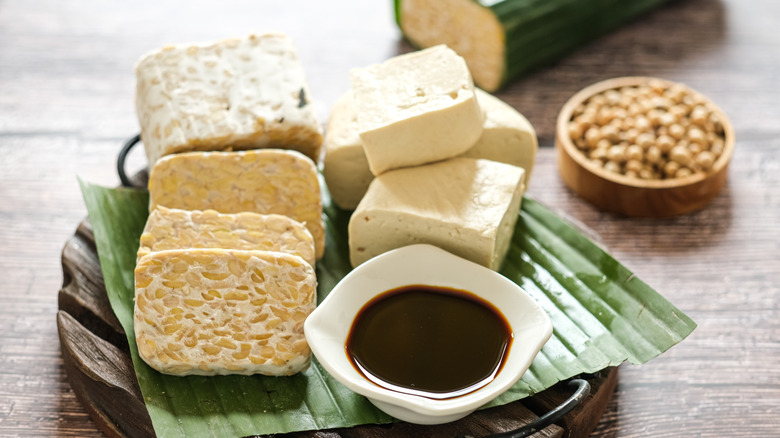Tempeh Vs Seitan: How These Two Popular Meat Substitutes Differ
Tempeh and seitan are two ingredients you might often hear mentioned in the same breath. One reason for this is their common usage: Both are plant-based meat substitutes and both have previously been considered a little niche in the West before their growing popularity in recent years. The staunchest of meat-eaters may have at least heard of tofu (though they may not know what tofu is really made of), but the words tempeh and seitan might still invoke blank looks on that front. These two foods are far from new or niche in Asia though, where they've existed for centuries and are prized for their protein content which surpasses that of tofu.
These similarities aside, tempeh and seitan are pretty darned different. Not only did they originate in different countries, they're also made with wildly different ingredients and processes, resulting in distinct textures and flavors: Tempeh is firm and chewy with a nutty flavor, while seitan offers a more meaty texture and mild flavor. Tempeh is soy-based and usually gluten-free; seitan is soy-free and always chock-full of gluten. Tempeh is a fermented food; seitan isn't. And the list goes on.
What is tempeh?
Tempeh is a dense, cake-like protein made of whole soybeans (which aren't the same thing as edamame) that have been fermented with an edible mold typically in the Rhizopus genus, a process that gives it a rind similar to that of blue cheese. Don't let that fuzzy outer layer or a few black or brown spots fool you into thinking your tempeh has gone bad, as they're not signs of spoilage. However, be aware that tempeh lasts in the fridge for only about five to seven days after opening. Generally, tempeh offers a pronounced umami-rich nuttiness, but certain grains or other types of beans are sometimes added to it, impacting the flavor, texture, and nutritional content of the final product.
It's generally accepted that tempeh originated on the Indonesian island of Java 300 to 400 years ago due to its mention in the Serat Centhini, a 12-volume work detailing Indonesian life in the 1600s. Today, it's most widely consumed in Java, where it's typically stir-fried or deep-fried, but other types of cooking methods are also possible. You can grill, bake, steam, or air-fry it — anything you'd do to meat, in short — but it's generally a good idea to tone down its bitter notes by steaming or simmering it first before you proceed with your recipe.
What is seitan?
Made from wheat gluten, seitan (pronounced say-tan) is a meat replacement that developed in China around the 6th century and was brought by vegetarian Buddhist monks to Japan. Today, you'll commonly find it in East Asian cuisine and vegetarian or vegan dishes worldwide — often as mock duck or mock chicken — and cooked in a variety of ways ranging from stir-fries, stews, to even grilled as a standalone protein. Much like tofu, it absorbs whatever sauces and seasonings you cook it with, allowing for a wide diversity of flavors. On its own, seitan has a subtle, bread-like taste.
Seitan is made by taking wheat flour dough and washing it with water to remove the starch, leaving behind a concentrated ball of gluten. This gluten is then seasoned and cooked, often by simmering, steaming, or baking. It's fairly easy to make seitan with this washing technique at home, but an even quicker preparation method involves using vital wheat gluten (VWG), in which the gluten has already been separated out, offering a bit of a shortcut. Seitan should last for up to 10 days in the fridge if stored in an airtight container with a bit of its cooking liquid.
Tempeh is a complete protein whereas seitan is not
Though both seitan and tempeh are high-protein foods, only whole soybean-based tempeh is a complete protein. This means that it provides all nine essential amino acids needed by your body — a trait not very common among plant-based proteins besides soy products like tofu and edamame. This doesn't mean that your body can't use the protein in seitan, only that you'll want to pair it with ingredients that provide lysine, the sole amino acid that gluten-based seitan is missing. You can get this through legumes such as chickpeas, lentils, or other beans; pairing these can be as simple as crumbling seitan into a stew with them. And, of course, combining seitan with tofu, soy milk, or edamame is another way to get your essential nine amino acids while enjoying the extra protein and chewy texture that seitan brings.
Another plus of tempeh, courtesy of its soybean foundation, is that it's a good source of fiber, with 7 grams in a 3-ounce serving. Seitan doesn't have much fiber (only 1 gram per 3 ounces) but it's typically a bit lower in carbohydrates than tempeh, which can be useful if you're trying to maintain a keto or low-carb lifestyle. Tempeh also contains gut-aiding probiotics — the good bacteria found in fermented foods like kimchi, yogurt, and some of the best cottage cheese brands – and prebiotics, which, among other benefits, can also positively influence the microbiota in the gut (via Healthline).
Seitan offers a remarkably meat-like texture, unlike tempeh
If you're looking for a plant-based food with a texture that actually stands a chance of replicating meat (at least in some recipes), set your sights on seitan. Its consistency can be shockingly similar to that of meat, especially mimicking the hearty chewiness of chicken. This is because gluten's proteins form a stretchy network when they're mixed with water; they're what gives bread its squishiness and elasticity. They do the same thing for seitan.
Tempeh, on the other hand, makes a good enough meat sub, but few would classify its texture as meaty. Though it does have its own level of chewiness, tempeh's particular type of density — though pleasing to many palates — makes it undeniably a cake of compressed soybeans; you can actually feel the beans as you chew! The comparative smoothness of seitan makes it better at mimicking muscle fibers, if that's something you're looking for. That's why so many mock meat products, from plant-based chicken to meatless hot dogs, feature seitan, and why it's an underrated protein for vegetarians who miss the bite of meat.
Tempeh and seitan cater to different dietary needs
Tempeh and seitan have their own range of nutritional benefits, but which one you choose also depends on the ingredients inside them. Gluten-intolerant individuals or people with Celiac disease should avoid eating seitan, which is made of gluten. This is one mock meat you'll have to miss, as there aren't really any options for gluten-free gluten. Any recipe purporting to result in gluten-free seitan probably involves either tofu or a mix of other flours such glutinous rice flour. That said, seitan is a soy-free food, but always check the list of ingredients on any store-bought seitan products to ensure that no soy has been added; seitan is found in a wide variety of plant-based processed foods which may contain other meat-free protein sources.
Tempeh is on the opposite end of the spectrum. With a foundation of whole soybeans, individuals with a soy allergy will want to steer clear of it. If you avoid gluten, however, this one is for you. Again, though, check labels on commercial tempeh products; it's not unheard of for wheat, such as barley, to be added. Soy sauce, which often contains gluten, is also commonly added to tempeh during prep or cooking, so if you're in a restaurant and need a gluten-free meal, be sure to ask.





